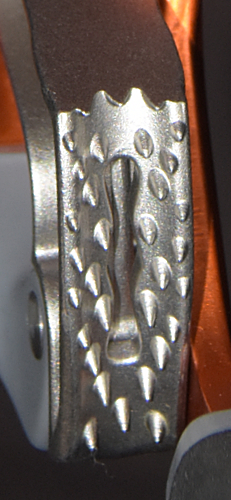Technical Details
I acquired my Black Diamond Index from Backcountry Gear in 2015.
The Black Diamond Index is 188 mm. tall, 90 mm. wide, 28 mm. thick, and weighs 205 g.
 The shell is a tall irregular shaped stamping made from 4.1 mm. aluminum alloy sheet metal. A 15 mm. wide rope channel
is formed in the upper portion of one side and a smaller cam channel
lies opposite the first. A hole drilled through both sides of
the cam channel accepts a 3.5 mm. rivet. The cam and cam spring
are mounted on this rivet. The handle below the cam has a two-component gray hard plastic and black soft "rubbery" hand grip molded into place. A 20.0 mm.
sling attachment hole is punched below the handle opening, and
an 10.0 mm. hole is punched below and outside the first. A
15.9 mm. hole punched through the back side of the rope channel aligns with a slightly larger 19.4 by 17.2 mm. hole in the front provides an attachment point just above the
cam. There are two more subrounded 4-sided holes in the rope channel that do not serve an attachment function. The shell has a stamped reinforcing rib that runs from the top of the handgrip over and down the front strap, and a second rib above the cam.
The shell is a tall irregular shaped stamping made from 4.1 mm. aluminum alloy sheet metal. A 15 mm. wide rope channel
is formed in the upper portion of one side and a smaller cam channel
lies opposite the first. A hole drilled through both sides of
the cam channel accepts a 3.5 mm. rivet. The cam and cam spring
are mounted on this rivet. The handle below the cam has a two-component gray hard plastic and black soft "rubbery" hand grip molded into place. A 20.0 mm.
sling attachment hole is punched below the handle opening, and
an 10.0 mm. hole is punched below and outside the first. A
15.9 mm. hole punched through the back side of the rope channel aligns with a slightly larger 19.4 by 17.2 mm. hole in the front provides an attachment point just above the
cam. There are two more subrounded 4-sided holes in the rope channel that do not serve an attachment function. The shell has a stamped reinforcing rib that runs from the top of the handgrip over and down the front strap, and a second rib above the cam.
The cam is a plated steel casting that has an L-shape rather than the traditional subtriangular shape. The cam radius increases from 37 to 56 mm. over an angle of 37°, giving a 32° cam angle. The cam has number of small conical teeth.
The upper teeth are parallel to the top of the cam, but the lower
teeth have their axes sloping downward. The tooth pattern is (3.4)(1S1)^10(2.1.2), where the S stands for a single logitudinal slot.
A plastic spring-loaded manual safety is riveted to the cam toe. The
normal action of the spring holds the safety against the cam.
When the cam is opened, the shell interferes with the safety bar,
thus preventing opening the cam. If the safety bar is moved away
from the cam (opposing the spring), it will clear the shell and
the cam will open. At full open the safety can be released and
the spring will hold the safety against the back of the shell.
This provides a means of locking the cam open.
The front of ascenders are printed behind the cam with an up-pointing arrow
beside the word "UP" and with the numbers "5008" on the left-hand and "4357" on the right-hand ascender. The rear of each is printed with a book-with-an-"i" icon, "CE0333," "EN 567:2013," and "ROPEØ8mm-13mm."
Black Diamond’s entry into the handled eccentric cam market deviates from the routine in several ways, and the result is a very nice ascender that weighs less than many others.
The Index is well made. All sharp edges have been
removed. The attachment points are simple yet well-rounded holes
in the shell; even so, I would consider their small radius too
sharp for directly attaching sling ropes. They are probably acceptably
rounded for webbing, but considering the proximity of the attachment
points to the main rope, I would recommend using a small maillon
for most attachments in order to reduce the risk of sling abrasion.
The lower attachment hole could theoretically have the same safety
problems as the one on Clog Version A.
The upper rope attachment hole is located very close to the main
rope. A carabiner through the upper oval attachment hole will
probably drag on the main line.
This ascender has the same pit lip disadvantage as the Clog and other stamped frame ascenders,
and there is no stamped reinforcing help prevent bending.
The safety is reasonably easy to use with one hand. I prefer to use it like a traditional ascender, opening and locking it open with the thumb only. I am not able to easily open and lock the ascender with the index finger alone.
The rubber handle is comfortable my large hands,
but I don't climb by gripping ascenders at their handle. I think
it is better to simply grasp the ascender from above and lift
the ascender in the traditional manner.
The cam is very well made. The cam teeth are sharp. Unfortunately, with the cam held open, I expect to cut my index finger.

For far more content, use a larger monitor and a full-width window.
Hundreds of cell phone users complained and asked me to for a simpler, mobile friendly site. In particular, they wanted me to limit each page to a small number of pictures and minimize my use of text. This new site provides what they asked for.

